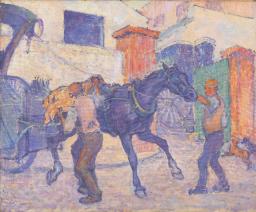Desmond MacCarthy, ‘Mr. Walter Sickert and the Camden Town Group’
Eye-Witness, 6 July 1911, pp.83–4..
[Beginning of article missing] the effect of these particular colours and shadows on the spectator is lugubrious. An artist cannot escape responsibility for producing such an effect by saying that shadows and colours should appeal simply to the eye, for colour and shadow have emotional qualities. At the Carfax Gallery, Mr. Sickert’s two studies of the Camden murder owe their impressiveness entirely to this emotional suggestiveness of light and shadow; the way the light from the window falls across the woman’s body and under the bed, leaving the figure of the man in sinister obscurity, is æsthetically beautiful, but it is also most expressive. Mr. Sickert has been accused by critics of misusing his talents in painting such a subject. The objection is absurd. His treatment shows no vulgar sensationalism or love of horror, but an imaginative interest well worth sharing.
“The First Exhibition of the Camden Town Group,” where these two pictures are to be seen, is a stimulating collection of pictures. Among the most interesting are three pictures by Mr. R.P. Bevan. They are pictures of a cabman’s yard. In one a lean but violent screw is still between the shafts, and two ostlers drawn in energetic attitudes, one at its head the other throwing a horse rug over its quarters, are in attendance upon it; behind is the bright green gate of the yard. In (28) a shabby man in a long coat is watching judicially two tired crocks taking a long draught at the trough; in the third a horse is just disappearing into the stable. The drawing of these objects – the figures, the animals, and the cabs – is vigorous and full of animation; the colour is imaginary and fantastic. The horse between the shafts is a violet horse, the gate-pillars are an apricot red, everywhere there is an unreal iridescence, the shabby box-cloth coat of the yardmaster has a dove-like sheen on it; yet this fanciful colouring does not interfere with the realism of the scene; it seems even to enhance it, as though this convention of unnatural, bright colour succeeded in conveying a sense of the life of the stable-yard which was still an important part of our actual impression of such scenes.
Mr. Lucien Pissaro [sic] has four pictures of patient and admirable honesty. Like his father, he has no wish to embellish anything in Nature and scorns to select her exceptional moods or to avoid the commonplace. They are all taken in bright sunlight. You can feel the touch of the east wind in his view of Colchester. The day he paints is one which everybody would describe on meeting an acquaintance as “very fine”; a perfect day for a coronation or a cricket match, but one on which the epicurean is apt to feel that there is not much that is interesting under the sun. His Acton railway bridge is perfectly successful.
Mr. Lamb shows two Breton boys and an admirable picture of a Breton fisherman with a long pole, at the base of a cliff. There is something dour in his art; the clayey green of which he is so fond is not in itself a pleasing colour, yet his pictures have a charm which lasts.
Neither of the two decorative landscape sketches by Augustus John is up to the mark of the best that were shown at the Chenil Gallery. These beautiful, lush blues and greens appeal to you at once, but, in the case of these two pictures, one feels that the effect has been made up after a prescription. The first exhibition of the “Camden Town Group” is as interesting as the New English exhibitions of early days.
Desmond MacCarthy
How to cite
Desmond MacCarthy, ‘Mr. Walter Sickert and the Camden Town Group’, in Eye-Witness, 6 July 1911, pp.83–4., in Helena Bonett, Ysanne Holt, Jennifer Mundy (eds.), The Camden Town Group in Context, Tate Research Publication, May 2012, https://www

